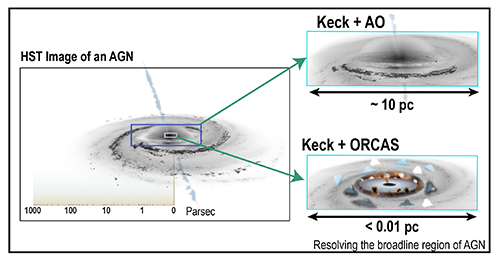Active Galactic Nuclei
Black holes with masses from a million to up to a billion times the mass of the Sun are now knownto be ubiquitous in the centers of galaxies, and their masses are known to correlate with properties of the host in which they reside. When accreting, the active galactic nucleus (AGN) can in turnexercise a profound effect over the baryonic component of the Universe by driving massive energeticoutflows that can suppress star formation in the host galaxy and expel as much as the entire massof a galaxy into the intergalactic medium. Despite their importance in shaping the evolution ofgalaxies, fundamental questions remain unanswered:
- How do supermassive black holes form?
- How do supermassive black holes grow to such tremendous sizes?
- How do supermassive black holes evolve with their host galaxies?
- What fundamental physics can we learn from AGNs?

Science Objectives:
- Detecting intermediate mass black holes,
- Detecting feedingand feedback signatures from the inner pc scales regions near supermassive black holes,
- Detecting supermassive black hole binaries in the near Universe.
Observable and Measurements:
- The proper motions of stars to find nurseries ofintermediate mass black holes in the nearby universe,
- High angular resolution imaging andspectroscopy to study in-flowing and out-flowing plasma in the inner parsecs of SMBH at thecenters of AGN,
- Imaging and spectroscopy to resolve dual and triple AGNs at parsec scaleseparations in the nearby Universe.
Key Functional Requirements:
- High angular resolution (~12 - 40 mas),
- High spectral resolution (up to ~10,000),
- High sensitivity (29th magnitude).
- Wavelengthcoverage from 0.5 - 2.0 µm.
ORCAS Uniqueness:
No other currently planned or commissioned instrument has sufficientangular resolution combined with spectral resolution and sensitivity to resolve the physical (~parsec) and dynamical (<20 km/s) scales required for the above science cases.
